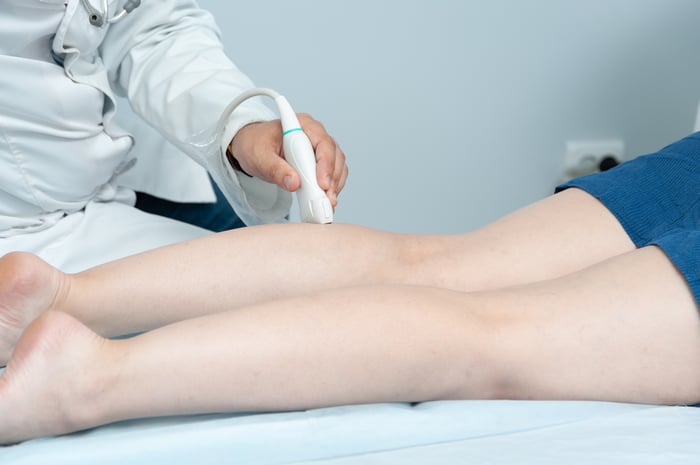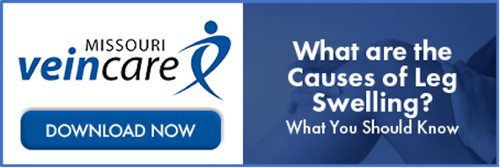How is Phlebitis Treated?

If you have or suspect you have phlebitis, you are likely all too familiar with the discomfort it can cause. It’s natural that the first question on your mind is how to treat it and find relief. Dealing with the tender, red, and swollen area can be worrying, and it’s important to know the right steps to take.
Phlebitis is inflammation of a vein, most often seen in the legs, that can cause redness, pain, and swelling in the affected area. In nearly every case, phlebitis should be evaluated with a leg vein ultrasound. This is a crucial step to determine if blood clots are present and to guide the best course of action. The most effective treatment methods for phlebitis can vary based on several factors, but the primary goal is always to reduce inflammation and make you more comfortable while your body heals. This healing process, it's important to understand, will likely take several weeks, at least.
Key Takeaways
- Phlebitis is an inflammation of a vein, often causing a tender, red, and swollen area on the leg. It requires a medical evaluation to be properly diagnosed.
- A leg vein ultrasound is almost always necessary after a phlebitis diagnosis. This is to rule out a more serious condition called Deep Vein Thrombosis (DVT).
- Treatment focuses on managing inflammation and pain with options like anti-inflammatory medication, cold or warm compresses, and sometimes compression stockings.
- Healing from phlebitis takes time, often several weeks to a few months. Patience is key, as the discomfort and discoloration will fade gradually.
Why is an Ultrasound So Important?
It is a very rare situation where you would not need a leg ultrasound after being diagnosed with phlebitis. We consider this the essential next step because there is a known link between phlebitis and Deep Vein Thrombosis (DVT), a more serious condition involving a blood clot in a deeper vein. The only way to know for sure if a DVT is present is through an ultrasound exam. This non-invasive test uses sound waves to create images of your veins, allowing a specialist to see what’s happening inside your leg and ensure you get the right treatment. Ignoring this step can be risky, so it’s always best to have it checked.
What Are the Treatment Options for Phlebitis?
Once your condition has been assessed, your treatment plan will focus on managing the symptoms and helping your body heal. Phlebitis isn't something that resolves overnight; it requires a consistent approach. Here are the most common treatment options you might discuss with your primary care provider.
Over-the-Counter Medication
One of the first lines of defense against the discomfort of phlebitis is anti-inflammatory medication. Medicines such as aspirin, ibuprofen (Advil, Motrin), or naproxen (Aleve) can significantly lessen the pain and inflammation associated with superficial phlebitis. For these to be most effective, you'll need to take them on a round-the-clock basis, following the dosage guidelines on the packaging. You can also add acetaminophen (Tylenol) to your routine. While it will help with the pain, it's important to remember that acetaminophen doesn't treat the underlying inflammation, which is the central source of the problem.
Steroid Medication
In some cases, your primary care provider might prescribe corticosteroids like Prednisone or a Medrol Dose Pack. These are powerful anti-inflammatory medications that can be very effective for treating phlebitis. The key to their success is starting them early. If you begin taking steroids after the inflammation has already become severe, you will likely still get some relief, but it may not be as complete. Early intervention can make a big difference in how quickly your symptoms improve.
Cold and Warm Therapy
Simple home remedies can provide surprising relief. At the very beginning of a phlebitis episode, applying a cold pack or ice bag to the affected area can greatly help with reducing both inflammation and swelling. As you move through the healing process over the next couple of weeks, you might find it more beneficial to switch to a heating pad. Warmth can promote blood flow and encourage healing. However, you’ll need to listen to your body. You'll know that heat is not helping if the area feels more painful after you use it. If that’s the case, switch back to an ice pack for comfort.
Compression Stockings
Compression stockings are often recommended for various vein-related issues, and they can be helpful during phlebitis recovery. That said, the timing is important. Early on, when the area is extremely tender, the pressure from a compression stocking might feel more painful than helpful. But as the initial tenderness subsides, it's worth trying them. Many patients find that at some point in their recovery, the gentle, consistent pressure helps reduce discomfort and swelling. You will have to figure out the right time for you by trying them on periodically as you heal.
Blood Thinners
If the ultrasound shows that the phlebitis is extensive, close to a deep vein, or might lead to a DVT, your primary care provider may recommend a course of blood thinners (anticoagulants). This is also the standard treatment if a DVT is already present. For people who are placed on blood thinners, the phlebitis often tends to resolve more quickly. This treatment is usually temporary and is weaned off after a few months, once the risk has passed.
Understanding the Healing Process
This is not often what patients like to hear, but it’s important to set realistic expectations: phlebitis may take weeks to months for the pain, swelling, and redness to resolve completely. The healing journey is gradual. Some people also end up with a permanent dark brown streak or discoloration on their skin where the phlebitis was located. This is known as post-inflammatory hyperpigmentation and, while it can be a cosmetic concern, it is not medically dangerous.
If you think you might have phlebitis, it is important to seek proper treatment and not dismiss your symptoms. While phlebitis is not always a serious or life-threatening condition, it certainly can be, and it should never be ignored. Reach out to your primary care provider to discuss your symptoms and determine if a vein ultrasound is the right next step for you. Getting a proper diagnosis is the first step toward feeling better.
Frequently Asked Questions (FAQs)
1. What does phlebitis feel like?
Phlebitis typically feels like a firm, tender, and warm cord or lump under the skin. The skin over the vein often appears red and can be quite painful to the touch. The discomfort may be a dull ache or a more sharp, burning sensation, and it is usually localized to the area of the inflamed vein.
2. Can phlebitis go away on its own?
While very mild cases might improve with home care like warm compresses and anti-inflammatory medication, you should never self-diagnose or ignore phlebitis. It requires a medical evaluation to rule out a more serious condition like DVT. Proper treatment helps manage pain, reduces inflammation, and prevents potential complications.
3. Is walking good for phlebitis?
Yes, gentle walking and movement are generally encouraged. Staying mobile helps promote healthy blood circulation in your legs, which can aid the healing process and reduce the risk of clots expanding. However, avoid strenuous activities that could worsen the pain. Listen to your body and rest as needed.
4. How long does it take for phlebitis to heal?
The recovery time for phlebitis varies. For superficial phlebitis, symptoms like pain and redness often begin to improve within one to two weeks, but the firmness of the vein can take several weeks or even a few months to fully resolve. Patience is an important part of the healing process.
5. When should I be worried about phlebitis?
You should contact your primary care provider immediately if the redness and swelling spread rapidly, if you develop a fever or chills, or if you experience shortness of breath or chest pain, as these could be signs of a DVT that has traveled to the lungs (a pulmonary embolism). It’s always best to get evaluated to be safe.


